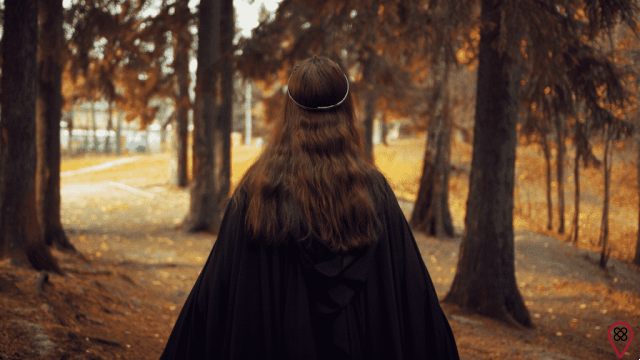What can an ancient Irish myth teach us about the dangers of objectifying a woman today? The answer is: a lot.
Next, let's get to know the story of the most beautiful woman in Ireland, Deirdre, and how she relates to female aesthetic standards.
Deirdre's story
Deirdre's tale of Sorrows involves beauty, lust and death. The story takes place in ancient Ireland, during the reign of King Conchobar Mac Nessa of Ulster.
It all started when a girl, the daughter of a chief and bard of the Ulaidh, was born. She was Deirdre. The baby was beautiful, and Cathbad the druid (a kind of Celtic priest) made a prophecy. He said that with each year of the girl's life, her beauty would increase, until she became the most beautiful woman in all of Ireland. But also for her beauty, she would bring war and sadness to the country.
When the news reaches the capital of Conchobar, the guards and knights decide to kill Deirdre to save Ireland. King Conchobar, however, wanted her under the care of a poet to marry her once she reached the age of consent.
Deirdre grew up, more and more beautiful, and one day she came across crows feeding on the corpse of a lamb. Horrified, she swore that love could only enter her heart if it were for a man whose hair was black as a raven's wing and whose lips were red as a lamb's blood.
It didn't take long for her to meet this man: it was Naoise, grandson of the druid who cast the prophecy. With the help of the poet, the two met and fell madly in love. However, they knew that King Conchobar could not discover this love.
Together with Naoise's younger brothers – Ainlé and Ardán – the couple fled to Glen Etive, where they lived happily for a while. But the king, unhappy with the escape, managed to find out where the family was. Because it was Caledonian territory, he had to come up with a plan.
The plan was to send one of his most honest knights, Fergus Mac Roth, saying that the king pardoned the couple and wished them to return home. Excited at the prospect of quelling their homesickness and believing in Fergus's honest reputation, they decided to return, even though Deirdre had her misgivings.

On their return, Naoise and her brothers, as well as the sons of Fergus Mac Roth, allayed Deirdre's suspicions, as if the king went back on his word, it would be a dishonor. Fergus himself was not present at the welcoming celebration, as he was on a royal mission.
However, just as they were about to be reunited with the king, he ordered all of his knights to capture Deirdre and kill the rest. Naoise, Fergus' brothers and sons fought to the death to defend Deirdre, but none survived, not even their love.
The druid Cathbad, disgusted by the king's betrayal, placed a curse on the man. Fergus, returning from the royal mission, swore revenge on his children and went to serve Conchobar's enemy, Queen Meabh.
Meanwhile, Conchobar took Deirdre to his quarters, but she refused to exchange a word with him for a year. Weary, the king handed her over to the warrior Eoghan Mac Durthact, who had slain the beloved Naoise. On the way, Deirdre threw herself from the carriage and smashed her own brains.
The remains of his body were buried next to Naoise's, from which two intertwined trees grew.
Love x passion x wonder

To understand the lessons that this myth brings us, we must first analyze Deirdre's relationship with the two men: Naoise and King Conchobar.
We will work here with three concepts: passion, love and wonder. According to Oxford dictionary definitions, passion is “feeling intense to the point of overshadowing reason”, love is “strong affection for another person”, and awe is the “state of mind of one who is overcome by lively admiration”. .
It is possible to say that both Naoise and King Conchobar had a crush on Deirdre. As strange as it may seem, we need to understand that both of them put reason aside because of their fascination with the most beautiful woman in Ireland. Naoise, for putting herself against the king's will in fleeing Conchobar; and the king, for going against his word and promoting bloodshed in his own kingdom.
The difference, perhaps, is that Naoise's passion turned into love. Together, they built a relationship and nurtured a very strong affection for each other. Not so with King Conchobar, who only sought the status of marrying the most beautiful woman in Ireland.
But the key point is, regardless of how they felt about Deirdre, none of the men ever cared about the girl's personality. Her stunning beauty was the only thing they cared about, for they never asked what her talents, her values, her ideas, or her opinions were. It lacked, therefore, the typical amazement of someone who admires the other for the whole, and not just for their appearance.
And this is precisely where the discussion about the objectification of the female body comes in.
The contemporary Deirdres
When we talk about objectification, we are referring to the overvaluation of the image of the woman beyond all other characteristics that define her as an individual. Weight, height, hair type and body shape matter more than what she can do, the subjects she studies and the talents she has.
This is what we see in beer advertisements, in which the waitresses appear hypersexualized.
That's what we see in the auditorium shows, in which women appear dancing in the background just to show their own bodies.
That's what we see in the movies, in thousands of different stereotypes that limit women only to what they look like.

This is what we see on social media, with the exposure of “photoshopped” bodies, which will never exist in real life.
Based on this and so many other references, women continue to be reduced to just the body and its ability to satisfy male sexual pleasure. Even without realizing it, they feel impelled to perform aggressive aesthetic procedures and fit into the current fashion to be accepted by men and also by other women. Often, the demand for a supposed “self-care” comes from within the family itself.
Anyone who is out of the norm is made invisible and suffers from self-demand. As a result, research published in 2013 in Psychological Science shows that women who objectify themselves more become less socially active.
Or they may still be victims of rape culture, as they are seen merely as an object of pleasure.
You might also like:
- Understand how respect is such a rare feeling
- Discover 10 lessons from strong women
- See how female empowerment passes through the body
Unfortunately, a myth as old as Deirdre das Sorrows is still able to represent the society in which we live very well. Female objectification goes from ancient Ireland to present-day España.









